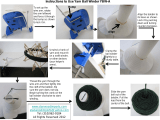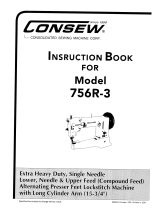Page is loading ...

Contents page:
Part 3: Servicing Instructions 550-16-23 and 550-16-26
1. General .................................................... 3
1.1 Gauges .................................................... 4
1.2 Description of the integral adjustment disc ............................... 5
1.3 Position of the integral adjustment disc with respect to the arm-shaft crank ........... 6
2. Upper/lower synchronous-belt shafts................................. 7
2.1 Position of the synchronous-belt pulley on the lower shaft ...................... 7
2.2 Upper/lower shaft synchronous-belt tension .............................. 8
3. Needle-bar height ............................................. 9
4. Shuttle .................................................... 10
4.1 Aligning the shuttle shaft .......................................... 10
4.2 Changing the shuttle-drive synchronous belt .............................. 12
4.3 Loop stroke and gap between shuttle tip and needle ......................... 13
4.4 Bobbin-housing holder ........................................... 14
5. Material feed................................................. 15
5.1 General .................................................... 15
5.2 Underfeed................................................... 17
5.2.1 Replacing the feed belts .......................................... 17
5.2.3 Feed-belt tension .............................................. 18
5.2.4 Replacing the drive belt .......................................... 19
5.3 Overfeed ................................................... 22
5.3.1 Feed belts: overview ............................................ 22
5.3.2 Changing the feed belts .......................................... 23
5.3.3 Tensioning the feed belts.......................................... 26
5.3.4 Drive-shaft play ............................................... 27
5.3.5 Changing the synchronous belt ...................................... 28
6. Sewing foot ................................................. 29
6.1 Height of the presser bar .......................................... 29
6.2 Sewing-foot lift ................................................ 30
6.3 Sewing-foot pressure ............................................ 31
6.4 Adjusting the sewing-foot stroke height ................................. 32
6.4.1 General .................................................... 32
6.4.2 Stroke timing ................................................. 32
6.4.3 Stroke height ................................................. 33
7. Thread cutter ................................................ 34
7.1 General .................................................... 34
7.2 Control cam for blade-movement timing ................................. 35
3

Contents page:
7.3 Cutter-blade position ............................................ 36
7.4 Counter-blade cut pressure ........................................ 37
8. Thread-guiding components ...................................... 38
8.1 Needle-thread tensioner .......................................... 38
8.2 Thread-tensioning spring.......................................... 39
8.3 Bobbin winder ................................................ 40
9. Proximity switch .............................................. 41
10. Lubrication ................................................. 42
10.1 Oil circulation................................................. 43
11. Maintenance ................................................. 44

3
1. General
These Servicing Instructions describe the adjustment of the 550-16-23
and 550-16-26functional sewing units.
CAUTION:
The activities described in these Servicing Instructions may only be
carried out by specialist personnel or other appropriately trained
persons.
Caution: danger of injury
Before all repair, conversion and maintenance work turn off the main
switch and isolate the machine from the pneumatic supply.
When carrying out adjustment work and function-testing with the
machine running, comply with all safety measures and take the utmost
care.
These Servicing Instructions describe the adjustment of the sewing
machine in a logical order. It must be borne in mind that various
adjustments are mutually dependent. The adjustment process must
therefore be carried out in the order given.
For all adjustments of stitch-forming components a flawless new
needle must be fitted.
NB:
On the 550-16-23/-26 functional sewing units some shafts have
flattened areas to simplify the adjustment of the machine.
In all adjustments using these flat areas the first screw in the direction
of rotation is placed on the flat area.
CAUTION:
All colour-marked components are factory-set. These settings should
not be altered except by specialists.
3

1.1 Gauges
The machine can be precisely adjusted and checked with the gauges
listed below.
The locking pin 1, which can be found in the machine’s accessory
pack, is used to lock the arm shaft in the various positions required for
adjustment.
Position Gauge Order-No. Use
1 Adjusting pin 9301 022 608 lock machine in positions A-F
2 Gauge 6279 290 120 align the shuttle shaft in the
shuttle column
3 Measuring pin 6279 290 010 adjust needle-bar height
4
2
1
3

1.2 Description of the integral adjusting disc
The machine can be locked in all adjustment positions using locking
pin 2 and the adjustment disc 3 integral to the synchronous-belt pulley
on the arm shaft.
There are 6 notches on the adjustment disc. These are marked
A, B, C, D, E and F on the hand-wheel 1.
Notch A (loop-stroke position) is deeper than the others.
The adjustment positions are as follows:
A: adjustment disc with respect to the groove in the arm-shaft
crank, loop stroke, gap between the shuttle tip and needle
C: control cam for thread cutter
B, D, E, F: vacant
5
3
21
2 3

1.3 Position of the integral adjustment disc with respect to the arm shaft
CAUTION:
Adjustments carried out with the adjusting disc will only be correct if
the disc itself has been adjusted as described below.
If the arm shaft is moved, all subsequent settings must be checked and
adjusted if necessary.
Caution: danger of injury
Turn off the main switch.
The position of the adjustment disc may only be
checked and adjusted with the machine switched off.
Regulation and inspection
Groove 4 and notch A of the adjustment disc integral to the
synchronous-belt pulley must coincide on the X-Yline.
–
Lock the arm shaft with a locking pin ora5mmØpininthe
arm-shaft groove 4 (through hole 3).@BLICKFANG-STR = With the
integral adjusting disc in position A it must be possible to pass the
locking pin through the hole 1.
Adjustment
–
Remove the bobbin-winder cover 2.
–
Insert the Allen key 5 in the hole to undo the screws of the belt
pulley 6 from above.
–
Lock the belt pulley in position A with the locking pin.
–
Insert a 5 mm-thick pin into the rig hole 3 and allow it to engage in
the arm-shaft groove 4.
–
Tighten the screws on the belt pulley 6.
The belt pulley must not be axially shifted.
–
Replace the bobbin-winder cover 2.
6
4
321
6 5

2. Upper/lower synchronous-belt shafts
2.1 Position of the synchronous-belt pulley on the lower shaft
Caution: danger of injury
Turn off the main switch.
The position of the lower belt pulley may only be inspected and
adjusted with the machine switched off.
Regulation and inspection
The first screw of the belt pulley 2 must bite on the flat area of the
lower shaft 1.
The lateral position of the belt pulley must be such that the belt runs
centrally to the upper belt pulley.
Adjusting the setting
–
Fold the machine back.
–
Undo the screws on the lower belt pulley.
–
Align the belt pulley laterally to the upper belt pulley.
–
Tighten the screws on the belt pulley.
–
Turn the hand-wheel and check that the belt is properly seated on
the upper belt pulley.
7
3
321

2.2 Upper/lower shaft synchronous-belt tension
Regulation and inspection
The tension in the belt should be such as to produce an exact
transmission between the upper and lower shafts.
Excessive belt tension may lead to disproportionate wear and noise.
Caution: danger of injury
Turn off the main switch.
The belt tension may only be checked and adjusted with the machine
switched off.
Correcting the belt tension
–
Remove the bobbin-winder cover.
–
Remove plastic bungs 1 and 2.
–
Undo screw 3.
–
Twist the belt tensioner 4 as required.
–
Retighten screw 3.
–
Replace plastic bungs 1 and 2.
–
Replace the bobbin-winder cover.
CAUTION: danger of breakage
After adjusting the belt tension, check the shuttle setting.
8
21
43

3. Needle-bar height
Caution: danger of injury
Turn off the main switch.
The needle-bar height may only be checked and adjusted with the
machine switched off.
Regulation and inspection
In the loop-stroke position (adjustment position A) the shuttle tip 7
must be at the centre of the needle 8 and 3 mm above the upper
edge 6 of the eye of the needle. The setting is checked with adjusting
pin 4.
–
Undo screw 3.
–
Remove the needle from the needle bar 2.
–
Push adjusting pin 4 into the needle bar as far as it will go.
–
Tighten screw 3.
–
Lock the machine in adjustment position A.
The foot of adjusting pin 4 must be in contact with the needle plate.
Adjustment
–
Unscrew the cover.
–
Undo screw 1.
–
Raise or lower the needle bar until the foot of adjusting pin 4
makes contact with the needle plate.
Caution:
Do not twist the needle bar when moving it.
–
Tighten screw 1.
–
Replace and screw down the cover.
Having the needle bar at the wrong height may cause:
–
damage to the shuttle tip
–
the shuttle thread to jam between the needle and the needle guard
–
faulty stitches and thread damage.
9
3
321
4
3mm
7
8
6
2
3
5

4. Shuttle
4.1 Aligning the shuttle shaft
Caution: danger of injury
Turn off the main switch.
The shuttle shaft may only be adjusted with the machine switched off.
Regulation and inspection
The shuttle shaft 1 is factory-aligned.
When it is correctly aligned the shuttle 3 is equidistant from the
shuttle-drive housing 2 at every point.
Adjustment
–
Undo screw 5.
–
Remove support 4.
10
3
21
4
5

–
Undo screw 7.
–
Remove the left and right casings 6 and 8.
–
Remove screws 10 and 12.
–
Remove the centre-holder 11 and needle plate 9.
–
Undo the shuttle screw 14 and extract the shuttle from the drive
housing.
–
Remove the synchronous belt 13.
–
Undo screws 16.
The shuttle support and shaft are loose.
–
Place the gauge 15 on the shaft.
–
Move the shaft laterally and vertically until the gauge 15 can be
pressed into the shuttle-drive housing.
–
Tighten screws 16.
CAUTION:
The shaft and drive wheel must move freely when rotated.
–
Remove the gauge 15.
–
Replace the belt 13.
–
Place the shuttle on the shaft, align and adjust
(see section 4.3).
11
3
12 11 10 9
876
14 13
16
15

4.2 Changing the shuttle-drive synchronous belt
Caution: danger of injury
Switch the machine off.
The belt may only be changed with the machine switched off.
Changing the belt
–
Remove screws 1 and 2 and cover 3.
–
Undo screw 5 on the sprocket 4.
–
Remove belt 9 from the shuttle shaft.
–
Push the lower belt pulley 7 with the shaft 6 to the right.
The belt can be removed to the left.
–
Pass the new belt 9 down through slit 8 and place it on the lower
belt pulley.
–
Push the lower belt pulley to the left and place shaft 6 against
sprocket 4.
–
Tighten screw 5 of sprocket 4.
–
Place belt 9 on the shuttle-shaft sprocket.
–
Adjust the loop stroke (see section 4.3).
12
32 1
987 654
9

4.3 Loop stroke and gap between shuttle tip and needle
Regulation and inspection
The loop stroke is the path taken by the needle bar from bottom dead
centre to the point at which the shuttle tip is at the centre of the needle.
The loop stroke is 1.8 mm long.
With the machine locked in position A the shuttle tip 1 must be at the
centre of the needle.
The gap between the shuttle tip 1 and the needle must be 0.1 mm.
Caution: danger of injury
Turn off the main switch.
The loop stroke and the gap between the shuttle tip and needle may
only be checked and adjusted with the machine switched off.
Adjustment
–
Remove the sewing foot and needle plate.
Fit a new needle.
–
Lock the machine in position A.
–
Undo the shuttle’s attaching screws 2.
–
Place the shuttle tip 1 at the centre of the needle.
The gap between the shuttle tip 1 and the throat
of the needle must be 0.1 mm.
–
Retighten the shuttle’s attaching screws 2.
–
Replace the sewing foot and needle plate.
3
13
2
2

4.4 Bobbin-housing holder
Caution: danger of injury
Turn off the main switch.
The bobbin-housing holder may only be adjusted with the machine
switched off.
Regulation and inspection
The gap between the bobbin-housing holder 1 and the centre of the
shuttle 2 must be at least equal to the thickness of the yarn so that the
yarn can pass freely through it.
Adjustment
–
Undo screw 3.
–
Set pin 1 to the centre of the shuttle.
–
Retighten screw 3.
14
31
21

5. Material feed
5.1 General
The upper and lower belt feeds are driven by two separate step
motors.
Step motor 1 for the lower belt feed is connected to the drive
transmission with a slip clutch.
Step motor 2 for the upper belt feed is directly connected to the feed
belts.
Power is transmitted by synchronous belt to the upper and lower feeds
(2 feed belts for each).
15
3
1
2

5.2 Underfeed
5.2.1 Changing the feed belts
Caution: danger of injury
Turn off the main switch.
The feed belts may only be changed with the machine switched off.
Changing the feed belts
–
Undo screw 2.
–
Pivot tension rollers 1 and 3 from the feed belts.
–
Loosen screws 4 and 5 and lift column head 8 with feed belts 7 off
column 6.
–
Remove feed belts.
–
Fit new belts.
First place them on the lower sprocket 9, then fit them onto the
column 6 together with the column head 8.
–
Tighten the column head with screws 4 and 5.
–
Screw tension rollers 1 and 3 onto the feed belts and secure the
position with screw 2.
17
3

5.2.3 Feed-belt tension
Regulation and inspection
The feed-belt tension should be such that the step length is exactly
transmitted.
Excessive feed-belt tension can produce disproportionate wear and
functional tension.
Caution: danger of injury
Turn off the main switch.
The feed-belt tension may only be adjusted with the machine switched
off.
–
Undo screw 2.
–
Lightly press rollers 1 and 3 against the feed wheels.
–
Retighten screw 2.
18
321

5.2.4 Changing the drive belt
Caution: danger of injury
Turn off the main switch.
The drive belt may only be changed with the machine switched off.
Releasing the feed-belt tension
–
Undo screw 2 and move tension rollers 1 and 3 away from the feed
belts 4.
The feed belts are loose.
Remove the drive unit
–
Fold back the head of the machine.
–
Loosen screws 5 and 6 and remove the bearing block 7 with the
shaft 8.
19
3
43 2 1
87 65

Changing the belt
–
Undo screw 11 on the slip clutch.
–
Undo screw 14 and remove the setting ring 15.
–
Undo screw 13 on the inner setting ring.
The screw is in contact with the flat area. Loosen the screw until
the setting ring can be pushed over the shaft.
–
Push the shaft 12 out to the left
as follows:
Insert a screwdriver between block 9 and sprocket 10 and lever the
sprocket to the left.
Undo screws on the sprocket 10.
Push the sprocket to the right and retighten screws.
Use the screwdriver to lever the sprocket 10 with the shaft to the
left until the sprocket with the drive belt is loosely in the belt-exit
opening.
–
Replace the belt.
–
Push shaft 12 in again and push on the inner setting ring and
sprocket, making sure the flat area is in the right position.
–
Push the shaft in until it is flush with the setting ring 15.
–
Tighten the setting ring 15 on the flat area of the shaft with
screw 14.
–
Retighten the sprocket screws, inner setting ring and slip clutch.
20
15 14 13 12 11
10 9
/











